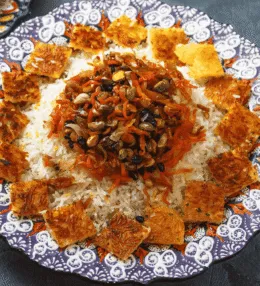
- View
Table of Contents
ToggleCao Lầu, a dish from Hoi An, Vietnam, is a culinary masterpiece that tells a story of tradition, flavour, and regional pride.
Known for its uniquely textured noodles, savoury toppings, and a harmonious balance of flavours, Cao Lầu is more than just a bowl of noodles, it’s an invitation to explore the cultural richness of central Vietnam.
A bite of Cao Lầu is like stepping into the historic streets of Hoi An, where the dish has been perfected over generations.
Want to dive deeper into Vietnamese Cuisine? Don’t miss our post on 30 Traditional Vietnamese Foods to Try
What Is Cao Lầu?
Cao Lầu is a traditional noodle dish that’s as distinct as the ancient town of Hoi An itself. The dish is centred on its signature noodles, which are made from a special type of rice and have a firm, chewy texture unlike any other.
These noodles are paired with thinly sliced pork, fresh herbs, crunchy bean sprouts, and crispy croutons. A small amount of broth, lightly seasoned, ties the dish together without overwhelming its delicate flavours.
What sets Cao Lầu apart from other Vietnamese noodle dishes is its subtle complexity. It’s not as soupy as pho or as bold as bun bo Hue, but its layered textures and harmonious balance of savoury, fresh, and slightly smoky flavours make it unforgettable.
Served with a squeeze of lime and a dash of chili, Cao Lầu offers a sensory experience that feels both refined and rustic.
Ingredients and Taste
The ingredients in Cao Lầu are simple yet meticulously chosen to create its signature taste. The noodles are the heart of the dish, made with rice flour soaked in water drawn from ancient Cham wells in Hoi An.
This water, said to contain unique minerals, gives the noodles their firm texture and yellowish hue. Thin slices of pork, often marinated and roasted, add a savoury richness, while fresh herbs such as cilantro and mint bring a bright, aromatic freshness.
Crunchy bean sprouts and crispy fried croutons provide a satisfying contrast to the tender noodles. The broth, made from pork bones and infused with light seasoning, is used sparingly, allowing the other components to shine.
The flavour profile is nuanced: the smoky aroma of the pork, the herbal notes from the greens, and the subtle sweetness of the noodles come together in perfect harmony. The addition of lime juice and chili creates a vibrant finish, making every bite a blend of textures and tastes.
A Taste of History
Cao Lầu’s origins are deeply intertwined with the history of Hoi An, a coastal town that was once a bustling port and trading hub. The dish reflects the influences of various cultures, including Chinese, Japanese, and local Cham traditions, which have shaped Hoi An’s culinary identity over centuries.
The name “Cao Lầu” translates to “high floor,” a reference to the practice of eating the dish on the upper levels of old merchant houses, where diners could enjoy their meal while overlooking the bustling streets below.
The unique preparation of the noodles is said to date back hundreds of years, with local families guarding the traditional techniques and passing them down through generations.
The use of water from ancient Cham wells and ash from certain trees to process the rice flour adds a sense of place and authenticity to the dish, making it a true product of Hoi An’s cultural landscape.

Vietnamese Cao Lầu (Hoi An Noodles)
Equipment
- Medium pot
- Skillet
- Saucepan
- Strainer
- Mixing bowls
- Serving bowls
Ingredients
For the Pork and Broth:
- 500 g pork belly
- 1.5 litres of water
- 2 tbsp soy sauce
- 1 tbsp fish sauce
- 1 tsp sugar
- 1 tsp five-spice powder
- 2 cloves garlic minced
- 1 small onion quartered
For the Noodles and Accompaniments:
- 400 g Cao Lầu noodles or thick rice noodles as a substitute
- 1 cup fresh bean sprouts
- 1 cup fresh lettuce shredded
- 1/2 cup fresh herbs Thai basil, mint, and cilantro
- 1/4 cup crispy pork skin or fried wonton crisps
- 2 limes cut into wedges
- 2 tbsp roasted peanuts crushed
- Chili sauce or fresh chili slices optional
Instructions
- To begin, prepare the pork and broth. In a medium pot, combine the water, soy sauce, fish sauce, sugar, five-spice powder, minced garlic, and quartered onion. Place the pork belly into the pot and bring it to a boil over medium heat. Skim off any impurities that rise to the surface, then reduce the heat to low. Cover and simmer for 45 minutes to 1 hour until the pork is tender.
- Remove the pork belly from the pot and let it rest for a few minutes. Slice the pork thinly and set aside. Reserve the broth, as this will be used to flavour the noodles and serve as a light soup.
- Prepare the Cao Lầu noodles according to the package instructions. If unavailable, thick rice noodles can be used as a substitute. Boil the noodles until just tender, then rinse under cold water to remove excess starch. Drain and set aside.
- Heat a skillet over medium heat and add 1 tablespoon of oil. Sear the sliced pork belly until golden and slightly crispy on the edges. Set the pork aside and keep it warm.
- Blanch the bean sprouts in boiling water for 30 seconds, then drain and set aside. Arrange the fresh lettuce and herbs on a serving platter for easy assembly.
- In a small saucepan, warm the reserved pork broth. Adjust the seasoning with additional fish sauce or soy sauce if needed for a balanced savoury flavour.
- Assemble the dish: Divide the noodles evenly among four bowls. Top each serving with seared pork slices, blanched bean sprouts, shredded lettuce, and a generous handful of fresh herbs. Sprinkle crushed peanuts and crispy pork skin (or fried wonton crisps) over the top.
- Ladle a small amount of the warm broth into each bowl for added flavour. Serve immediately with lime wedges on the side for squeezing over the noodles and optional chili sauce or fresh chili slices for heat. Enjoy the delicate balance of savoury pork, fresh herbs, and chewy noodles that define this iconic dish from Hoi An.
Nutrition
You May Also Like






